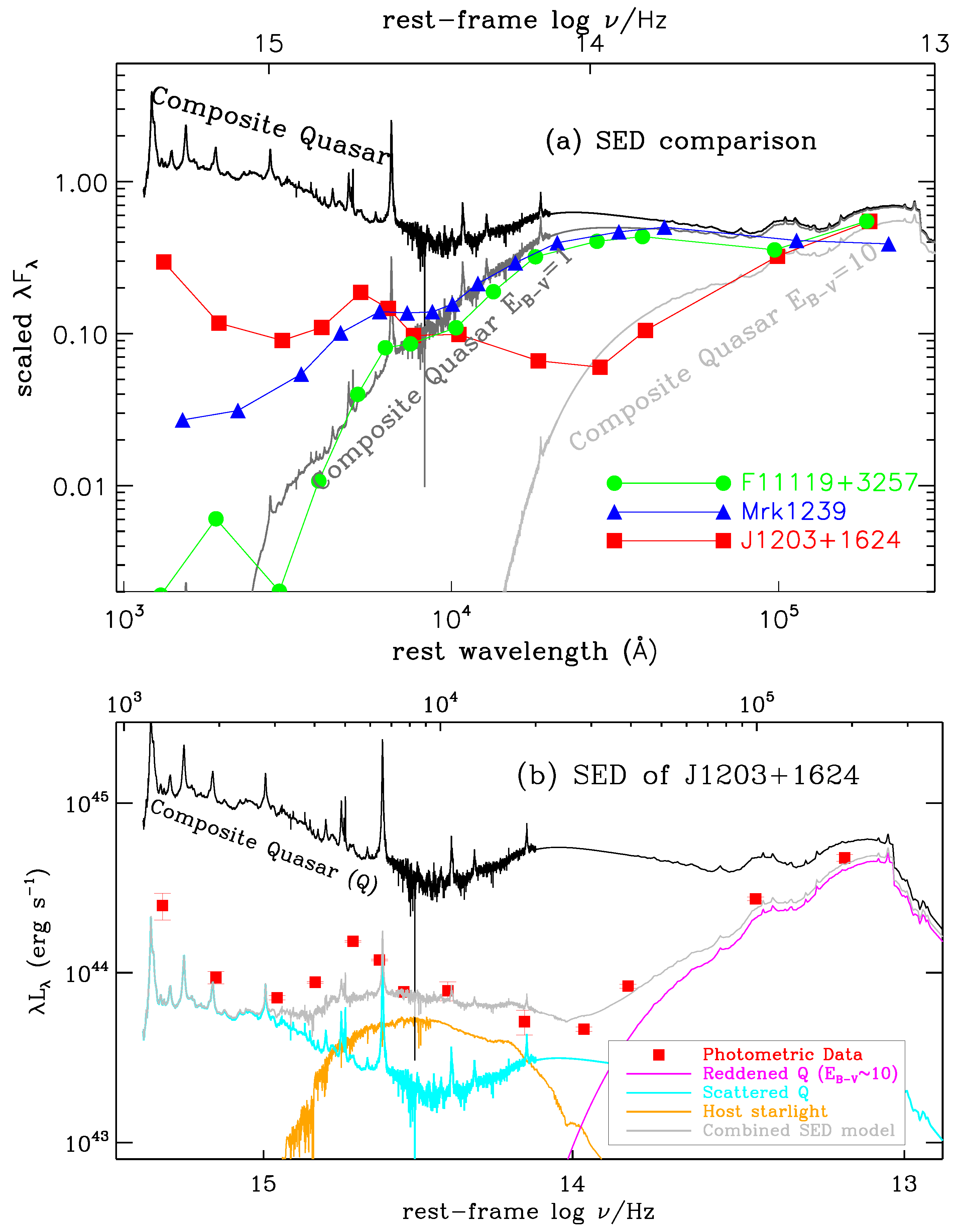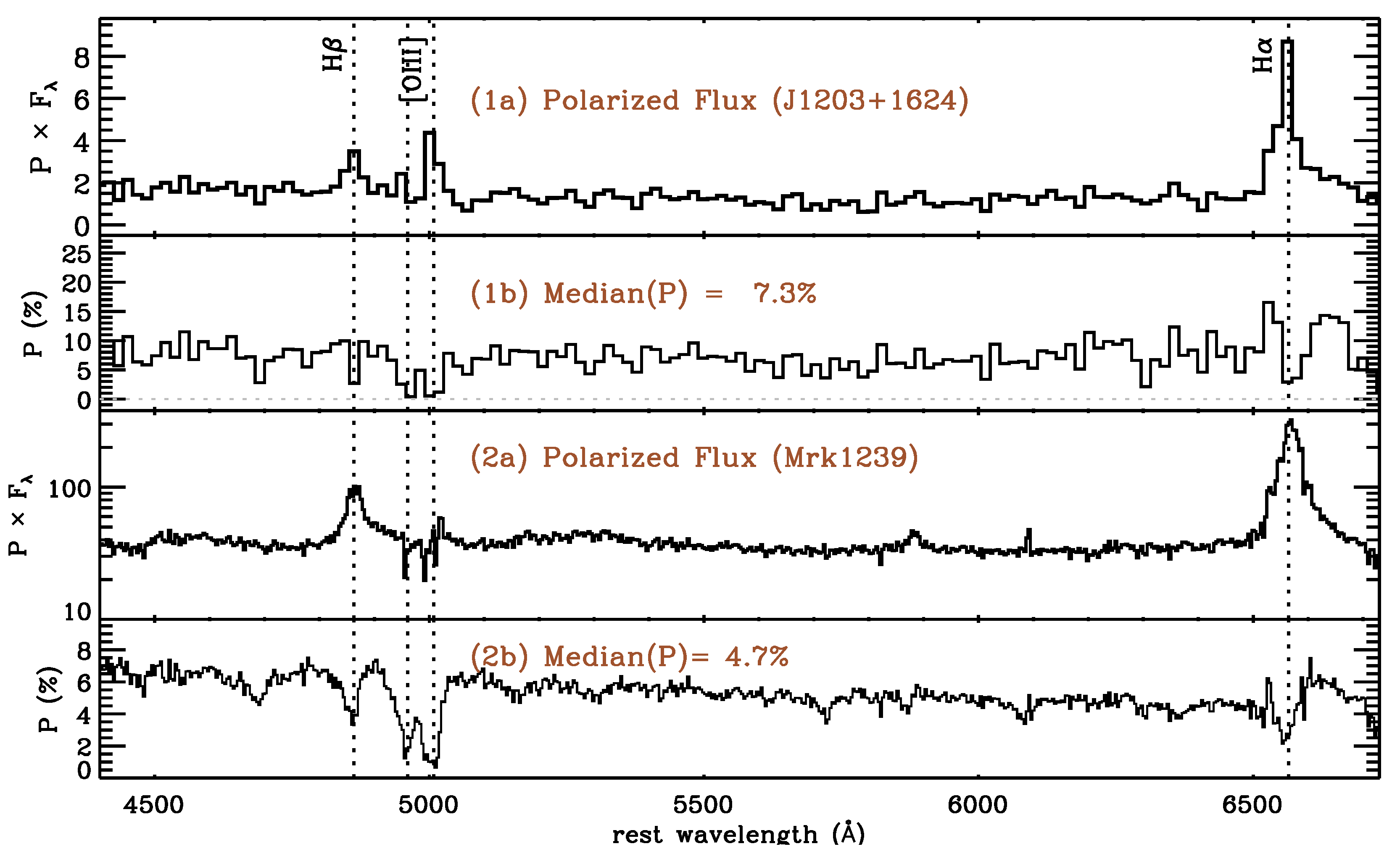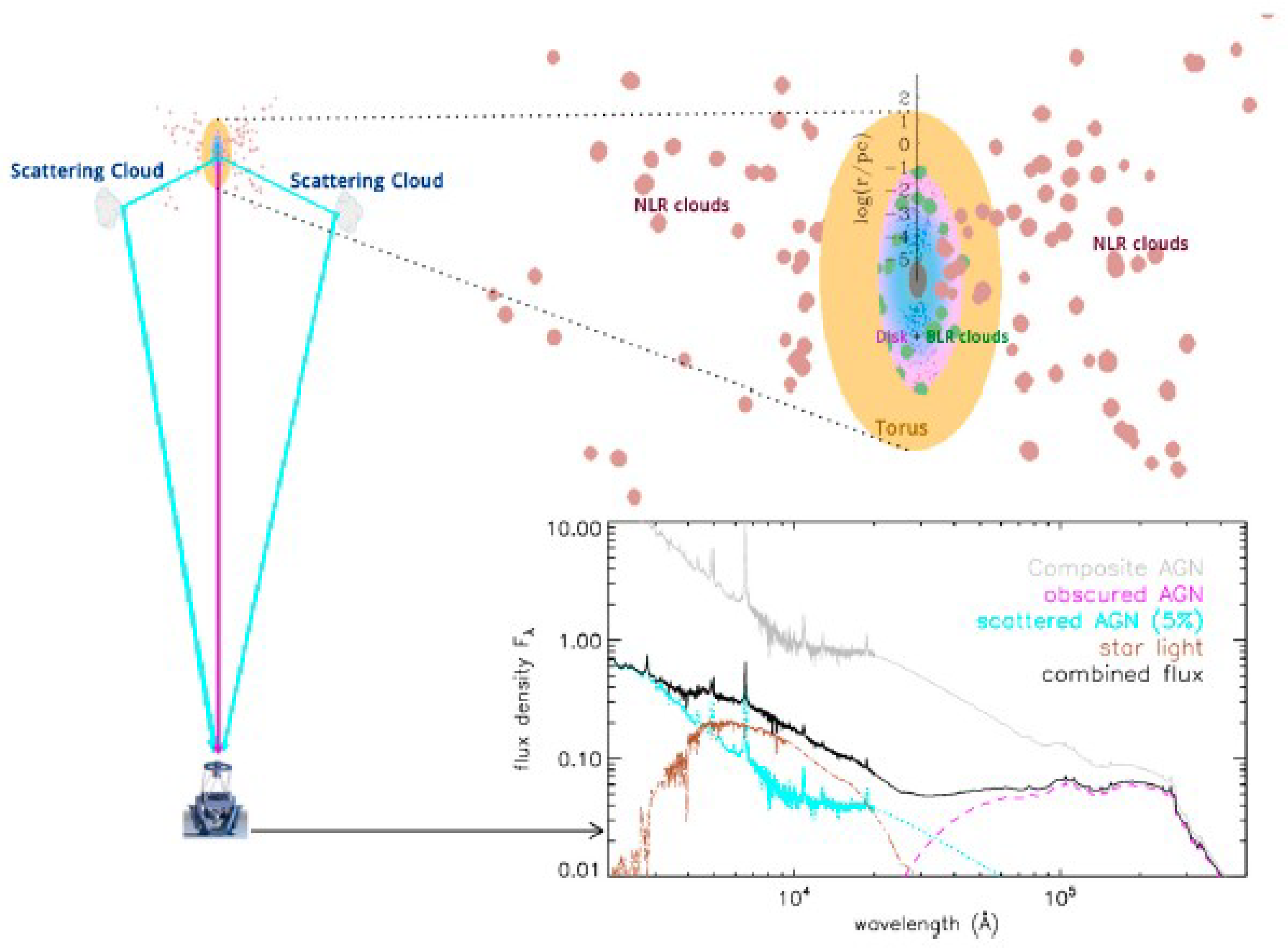Obscuration and Scattering in Narrow-Line Seyfert 1s
Abstract
1. Introduction
2. Obscuration in NLS1s
3. Scattering in NLS1s
4. The Host Galaxies of Obscured NLS1s
5. Summary and Prospect
Author Contributions
Funding
Conflicts of Interest
Abbreviations
| SED | Spectral Energy Distribution |
| NLS1 | Narrow-Line Seyfert 1 |
| AGN | Active Galactic Nuclei |
| BEL | Broad Emission Line |
| BELR | Broad Emission Line Region |
| Full Width at Half Maximum | |
| Galaxy Evolution Explorer | |
| SDSS | Sloan Digital Sky Survey |
| 2MASS | the Two Micron All Sky Survey |
| Wide-field Infrared Survey Explorer | |
| SMC | Small Magellanic Cloud |
| SSP | Simple Stellar Population |
| BAL | Broad Absorption Line |
| MMT/SPOL | Image Spectropolarimeter on the Multiple-Mirror Telescope |
| MMT/BC | Blue Channel Spectrograph on the Multiple-Mirror Telescope |
Appendix A. Observation and Data Analysis
| Wavelength Coverage | Telescope/Instrument | Date of Observation | References |
|---|---|---|---|
| F11119+3257 | |||
| 3610–10,390 [Å] | SDSS/BOSS | Mar 2013 | [36] |
| 9800–24,500 [Å] | P200/TSpec | 24 Feb 2013 | [24] |
| Mrk 1239 | |||
| 4000–7600 [Å] | 6dFGS | 26 Apr 2004 | [22] |
| 3350–7560 [Å] | MMT/BC | 27 Dec 2011 | [30] |
| 4200–8200 [Å] | MMT/SPOL | 5 Apr 2016 | [30] |
| 9800–24,500 [Å] | P200/TSpec | 23 Feb 2013 | [30] |
| J120300.19+162443.7 | |||
| 3100–9180 [Å] | SDSS | 17 Apr 2007 | [19] |
| 3350–5100 [Å] | MMT/BC | 27 Dec 2011 | [25] |
| 8770–9520 [Å] | MMT/BC | 29 Feb 2012 | [25] |
| 3200–10,200 [Å] | MMT/BC | 1 Feb 2012 | [25] |
| 9800–24,500 [Å] | P200/TSpec | 23 Feb 2013 | [25] |
| 4200–8200 [Å] | MMT/SPOL | 5 Apr 2016 | [25] |
Appendix B. Photoionization Modelling

References
- Khachikian, E.Y.; Weedman, D.W. An atlas of Seyfert galaxies. Astrophys. J. 1974, 192, 581–589. [Google Scholar] [CrossRef]
- Osterbrock, D.E.; Koski, A.T. NGC 4151 and Markarian 6—Two intermediate-type Seyfert galaxies. Mon. Not. R. Astron. Soc. 1976, 176, 61P–66P. [Google Scholar] [CrossRef]
- Antonucci, R. Unified models for active galactic nuclei and quasars. Annu. Rev. Astron. Astrophys. 1993, 31, 473–521. [Google Scholar] [CrossRef]
- Zhou, H.; Wang, T.; Yuan, W.; Lu, H.; Dong, X.; Wang, J.; Lu, Y. A Comprehensive Study of 2000 Narrow Line Seyfert 1 Galaxies from the Sloan Digital Sky Survey. I. The Sample. Astrophys. J. Suppl. Ser. 2006, 166, 128–153. [Google Scholar] [CrossRef]
- Osterbrock, D.E.; Pogge, R.W. The spectra of narrow-line Seyfert 1 galaxies. Astrophys. J. 1985, 297, 166–176. [Google Scholar] [CrossRef]
- Leighly, K.M. A Comprehensive Spectral and Variability Study of Narrow-Line Seyfert 1 Galaxies Observed by ASCA. I. Observations and Time Series Analysis. Astrophys. J. Suppl. Ser. 1999, 125, 297–316. [Google Scholar] [CrossRef]
- Leighly, K.M. A Comprehensive Spectral and Variability Study of Narrow-Line Seyfert 1 Galaxies Observed by ASCA. II. Spectral Analysis and Correlations. Astrophys. J. Suppl. Ser. 1999, 125, 317–348. [Google Scholar] [CrossRef]
- Jin, C.; Ward, M.; Done, C. A combined optical and X-ray study of unobscured type 1 active galactic nuclei—II. Relation between X-ray emission and optical spectra. Mon. Not. R. Astron. Soc. 2012, 422, 3268–3284. [Google Scholar] [CrossRef]
- Jin, C.; Ward, M.; Done, C. A combined optical and X-ray study of unobscured type 1 active galactic nuclei—III. Broad-band SED properties. Mon. Not. R. Astron. Soc. 2012, 425, 907–929. [Google Scholar] [CrossRef]
- Nagar, N.M.; Oliva, E.; Marconi, A.; Maiolino, R. NGC 5506 unmasked as a Narrow Line Seyfert 1: A direct view of the broad line region using near-IR spectroscopy. Astron. Astrophys. 2002, 391, L21–L24. [Google Scholar] [CrossRef]
- Ramos Almeida, C.; Pérez García, A.M.; Acosta-Pulido, J.A.; González-Martín, O. Unveiling the Narrow-Line Seyfert 1 Nature of Markarian 573 Using Near-Infrared Spectroscopy. Astrophys. J. 2008, 680, L17. [Google Scholar] [CrossRef]
- Komossa, S.; Voges, W.; Xu, D.; Mathur, S.; Adorf, H.-M.; Lemson, G.; Duschl, W.J.; Grupe, D. Radio-loud Narrow-Line Type 1 Quasars. Astron. J. 2006, 132, 531–545. [Google Scholar] [CrossRef]
- Rakshit, S.; Stalin, C.S.; Chand, H.; Zhang, X.-G. A Catalog of Narrow Line Seyfert 1 Galaxies from the Sloan Digital Sky Survey Data Release 12. Astrophys. J. Suppl. Ser. 2017, 229, 39. [Google Scholar] [CrossRef]
- Zhang, S.; Zhou, H.; Shi, X.; Liu, W.; Pan, X.; Jiang, N.; Ji, T.; Jiang, P.; Wang, S. Reddening and *λ10830 Absorption Lines in Three Narrow-line Seyfert 1 Galaxies. Astrophys. J. 2017, 845, 126. [Google Scholar] [CrossRef]
- Vanden Berk, D.E.; Richards, G.T.; Bauer, A.; Strauss, M.A.; Schneider, D.P.; Heckman, T.M.; York, D.G.; Hall, P.B.; Fan, X.; Knapp, G.R.; et al. Composite Quasar Spectra from the Sloan Digital Sky Survey. Astron. J. 2001, 122, 549–564. [Google Scholar] [CrossRef]
- Glikman, E.; Helfand, D.J.; White, R.L. A Near-Infrared Spectral Template for Quasars. Astrophys. J. 2006, 640, 579–591. [Google Scholar] [CrossRef]
- Netzer, H.; Lutz, D.; Schweitzer, M.; Contursi, A.; Sturm, E.; Tacconi, L.J.; Veilleux, S.; Kim, D.-C.; Rupke, D.; Baker, A.J.; et al. Spitzer Quasar and ULIRG Evolution Study (QUEST). II. The Spectral Energy Distributions of Palomar-Green Quasars. Astrophys. J. 2007, 666, 806–816. [Google Scholar] [CrossRef]
- Morrissey, P.; Conrow, T.; Barlow, T.A.; Small, T.; Seibert, M.; Wyder, T.K.; Budavári, T.; Arnouts, S.; Friedman, P.G.; Forster, K.; et al. The Calibration and Data Products of GALEX. Astrophys. J. Suppl. Ser. 2007, 173, 682–697. [Google Scholar] [CrossRef]
- York, D.G.; Adelman, J.; Anderson, J.E.; Anderson, S.F.; Annis, J.; Bahcall, N.A.; Bakken, J.A.; Barkhouser, R.; Bastian, S.; Berman, E.; et al. The Sloan Digital Sky Survey: Technical Summary. Astron. J. 2000, 120, 1579–1587. [Google Scholar] [CrossRef]
- Skrutskie, M.F.; Cutri, R.M.; Stiening, R.; Weinberg, M.D.; Schneider, S.; Carpenter, J.M.; Beichman, C.; Capps, R.; Chester, T.; Elias, J.; et al. The Two Micron All Sky Survey (2MASS). Astron. J. 2006, 131, 1163–1183. [Google Scholar] [CrossRef]
- Wright, E.L.; Eisenhardt, P.R.M.; Mainzer, A.K.; Ressler, M.E.; Cutri, R.M.; Jarrett, T.; Kirkpatrick, J.D.; Padgett, D.; McMillan, R.S.; Skrutskie, M.; et al. The Wide-field Infrared Survey Explorer (WISE): Mission Description and Initial On-orbit Performance. Astron. J. 2010, 140, 1868–1881. [Google Scholar] [CrossRef]
- Jones, D.H.; Read, M.A.; Saunders, W.; Colless, M.; Jarrett, T.; Parker, Q.A.; Fairall, A.P.; Mauch, T.; Sadler, E.M.; Watson, F.G.; et al. The 6dF Galaxy Survey: Final redshift release (DR3) and southern large-scale structures. Mon. Not. R. Astron. Soc. 2009, 399, 683–698. [Google Scholar] [CrossRef]
- Martin, N.; Maurice, E.; Lequeux, J. The structure of the Small Magellanic Cloud. Astron. Astrophys. 1989, 215, 219–242. [Google Scholar]
- Pan, X.; Zhou, H.; Liu, W.; Liu, B.; Ji, T.; Shi, X.; Zhang, S.; Jiang, P.; Wang, H.; Hao, L. Discovery of Metastable * λ10830 Mini-broad Absorption Lines and Very Narrow Paschen α Emission Lines in the ULIRG Quasar IRAS F11119+3257. Astrophys. J. 2019, 883, 173. [Google Scholar] [CrossRef]
- Pan, X.; Lu, H.; Komossa, S.; Xu, D.; Yuan, W.; Sun, L.; Smith, P.S.; Zhang, S.; Jiang, P.; Yang, C.; et al. A Deeply Buried Narrow-line Seyfert 1 Nucleus Uncovered in Scattered Light. Astrophys. J. 2019, 870, 75. [Google Scholar] [CrossRef]
- Liu, W.-J.; Zhou, H.; Ji, T.; Yuan, W.; Wang, T.-G.; Jian, G.; Shi, X.; Zhang, S.; Jiang, P.; Shu, X.; et al. A Comprehensive Study of Broad Absorption Line Quasars. I. Prevalence of * Absorption Line Multiplets in Low-ionization Objects. Astrophys. J. Suppl. Ser. 2015, 217, 11. [Google Scholar] [CrossRef]
- Goodrich, R.W.; Miller, J.S. Spectropolarimetry of the Unusual High-Polarization Quasar OI 287. Astrophys. J. 1988, 331, 332. [Google Scholar] [CrossRef]
- Bruzual, G.; Charlot, S. Stellar population synthesis at the resolution of 2003. Mon. Not. R. Astron. Soc. 2003, 344, 1000–1028. [Google Scholar] [CrossRef]
- Dewangan, G.C.; Griffiths, R.E. Type 2 Counterparts of Narrow-Line Seyfert 1 Galaxies. Astrophys. J. 2005, 625, L31–L34. [Google Scholar] [CrossRef]
- Pan, X.; Zhou, H.; Sun, L.; Smith, P.; Yang, C.; Ji, T.; Jiang, N.; Jiang, P.; Liu, W.; Lu, H.; et al. Extinction, Absorption, and Reflection in A Prototype Narrow-Line Seyfert 1, Mrk 1239. Astrophys. J. 2020, submitted. [Google Scholar]
- Ramos Almeida, C.; Levenson, N.A.; Rodríguez Espinosa, J.M.; Alonso-Herrero, A.; Asensio Ramos, A.; Radomski, J.T.; Packham, C.; Fisher, R.S.; Telesco, C.M. The Infrared Nuclear Emission of Seyfert Galaxies on Parsec Scales: Testing the Clumpy Torus Models. Astrophys. J. 2009, 702, 1127–1149. [Google Scholar] [CrossRef]
- Young, S.; Axon, D.J.; Robinson, A.; Hough, J.H.; Smith, J.E. The rotating wind of the quasar PG 1700+518. Nature 2007, 450, 74–76. [Google Scholar] [CrossRef] [PubMed][Green Version]
- Kormendy, J.; Ho, L.C. Coevolution (Or Not) of Supermassive Black Holes and Host Galaxies. Annu. Rev. Astron. Astrophys. 2013, 51, 511–653. [Google Scholar] [CrossRef]
- Drake, A.J.; Djorgovski, S.G.; Mahabal, A.; Beshore, E.; Larson, S.; Graham, M.J.; Williams, R.; Christensen, E.; Catelan, M.; Boattini, A.; et al. First Results from the Catalina Real-Time Transient Survey. Astrophys. J. 2009, 696, 870–884. [Google Scholar] [CrossRef]
- Schmidt, G.D.; Stockman, H.S.; Smith, P.S. Discovery of a Sub-Megagauss Magnetic White Dwarf through Spectropolarimetry. Astrophys. J. 1992, 398, L57. [Google Scholar] [CrossRef]
- Ahn, C.P.; Alexandroff, R.; Allende Prieto, C.; Anders, F.; Anderson, S.F.; Anderton, T.; Andrews, B.H.; Aubourg, É.; Bailey, S.; Bastien, F.A.; et al. The Tenth Data Release of the Sloan Digital Sky Survey: First Spectroscopic Data from the SDSS-III Apache Point Observatory Galactic Evolution Experiment. Astrophys. J. Suppl. Ser. 2014, 211, 17. [Google Scholar] [CrossRef]
- Ferland, G.J.; Korista, K.T.; Verner, D.A.; Ferguson, J.W.; Kingdon, J.B.; Verner, E.M. CLOUDY 90: Numerical Simulation of Plasmas and Their Spectra. Publ. Astron. Soc. Pac. 1998, 110, 761–778. [Google Scholar] [CrossRef]
- Tombesi, F.; Meléndez, M.; Veilleux, S.; Reeves, J.N.; González-Alfonso, E.; Reynolds, C.S. Wind from the black-hole accretion disk driving a molecular outflow in an active galaxy. Nature 2015, 519, 436–438. [Google Scholar] [CrossRef]




| Object Name | km s−1 | EB–V mag | References | ||||
|---|---|---|---|---|---|---|---|
| F11119+3257 | 1980 | 10 | ≈1.2 | 1.0 | ≈1 | - | [24] |
| Mrk 1239 | 10 | ≈1.6 | 6.4 | ≈0.6 | [30] | ||
| J120300.19+162443.7 | ∼10 | < | >1.5 | [25] | |||
| NGC 5506 | 1800 | 10 | ∼2 | 5.3 | ∼0.1 | - | [10], this paper |
| Mrk 573 | 10 | ∼3.5 | ∼ | ∼0.1 | - | [11,31], this paper |
© 2020 by the authors. Licensee MDPI, Basel, Switzerland. This article is an open access article distributed under the terms and conditions of the Creative Commons Attribution (CC BY) license (http://creativecommons.org/licenses/by/4.0/).
Share and Cite
Pan, X.; Zhou, H.; Jiang, P. Obscuration and Scattering in Narrow-Line Seyfert 1s. Universe 2020, 6, 73. https://doi.org/10.3390/universe6060073
Pan X, Zhou H, Jiang P. Obscuration and Scattering in Narrow-Line Seyfert 1s. Universe. 2020; 6(6):73. https://doi.org/10.3390/universe6060073
Chicago/Turabian StylePan, Xiang, Hongyan Zhou, and Peng Jiang. 2020. "Obscuration and Scattering in Narrow-Line Seyfert 1s" Universe 6, no. 6: 73. https://doi.org/10.3390/universe6060073
APA StylePan, X., Zhou, H., & Jiang, P. (2020). Obscuration and Scattering in Narrow-Line Seyfert 1s. Universe, 6(6), 73. https://doi.org/10.3390/universe6060073





